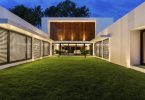LEED (Leadership in Energy and Environmental Design) is the most commonly used green building rating system that is accepted and recognized globally. There are LEED-certified buildings all over the world that is used for residential as well as commercial purposes. A LEED certification is not only a framework for highly efficient, healthy, and cost-saving green buildings but it also symbolizes sustainability and leadership. This certification is applicable for all building types including new or old construction and homes that are looking to become sustainable. The demand for green buildings is growing and LEED property managers are taking responsibility for the environmental performance of their facility.
A LEED certification involves four main steps:
1. Registration
The project can be registered by completing key forms and after submitting the payment. It is an important step in the certification process. Before you apply, you must ensure that the project is compliant with all of the LEED Minimum Program Requirements. These are the characteristics that make a project suitable for pursuing a LEED certification. These requirements include:
For LEED 2009 certification: Commercial Projects
- The project should comply with environmental laws
- It should be a complete and permanent building
- It should comply with minimum floor area requirements
- It should comply with a minimum building area to site area ratio
- The project must use a reasonable site boundary
- It should comply with minimum occupancy requirements
- The project is agreeable to sharing whole-building energy and water usage data
For LEED v4 certification: Commercial Projects
- The building project should be in a permanent location on existing land
- It should comply with project size requirements
- It should use reasonable LEED boundaries
LEED certification requirements: Residential projects:
- The project should be defined as a residential unit by all applicable codes. Every unit must have a cooking area and a bathroom
- The building should be in a permanent location on existing land
- It must use reasonable LEED project boundaries
- It should be a complete and permanent building. A building cannot be partially certified. A single unit in multi-unit buildings cannot apply for a standalone LEED certification unless the entire building is registered for applying. Every such unit in a multi-unit building must be awarded the same certification level.
- LEED residential projects require on-site verification and performance by a LEED Green Rater
2. Applying
You can apply for LEED certification by submitting your completed certification application and paying a certification review fee.
Next is selecting the rating system. There are currently six rating systems with each having different categories to earn points.
- Building Design and Construction
- Interior Design and Construction
- Operations and Maintenance
- Residential
- Cities and Communities
- Recertification
The categories under the rating systems are:
- Location & Transportation
- Energy & Atmosphere
- Indoor Environmental Quality
- Materials & Resources
- Sustainable Sites
- Water Efficiency
- Innovation
The easiest and most cost-effective points under the operations and maintenance rating system to achieve are:
- The indoor environmental quality which caters to implementing and adhering to a green cleaning and waste disposal policy.
- Materials and resources which includes monitoring the waste performance, purchasing and using environmentally friendly products and equipment
- Water efficiency which is about is about monitoring and reducing the amount of water used by the building
Once the points are submitted they are then reviewed and for every point earned, it is added to the total worth of the project. Depending on the number of points earned by a project it is certified Silver, Gold, or Platinum.
3. Review.
The LEED application is reviewed by Green Business Certification Inc. (GBCI).
4. Certification
You will receive the certification if the application is accepted after review.
Economic benefits of LEED
- Gives a competitive edge– A LEED project signifies sustainability which leads to market differentiation. It also leads to improved financial performance for the builder. LEED improves the project’s image and establishes the builder as a leader in green buildings.
- Attracts potential customers– LEED buildings can charge higher rentals and the lease rates for such projects are also higher than other projects. Green buildings have a lower vacancy rate than non-green buildings.
- Performance management– LEED is the world’s top green building project and performance management system. It provides a comprehensive and structured framework for green building designs along with their construction, operations, and performance.
- Investor goals– LEED certification provides the investors with a globally recognized green building framework which they can use to measure and manage the real estate performance of their investment
- Reduced costs– Since green buildings use fewer resources like water and energy and generate less waste, the operational and utility costs for these buildings are low.
Green benefits of LEED
- Clean and green spaces– LEED creates greener and healthier projects that have access to sunlight and are free from the toxic fumes of paints and furnishings. LEED certification for schools and healthcare facilities is extremely important for providing a healthy indoor environment with improved air quality.
- Reduced pollution levels– Energy-efficient buildings help in reducing the pollution levels by improving the outdoor air quality in industrialized areas. LEED plays a key role in reducing smog through its green projects.
- Improved indoor environment– LEED projects experience an improved indoor air quality which reduces respiratory allergies, depression, and stress. Not only does it improve health but also the productivity of people. Employees in green buildings display a higher level of productivity as they are exposed to fewer volatile organic compound (VOC) emissions.
Reduced carbon footprint
- The expected water savings from LEED commercial buildings are more than all non-residential buildings’ water usage.
- According to statistics, LEED projects will divert more than 540 million tons of waste from landfills by 2030.
- Because of the efficient locations and alternative transportation options, occupants of LEED buildings reduce the vehicle miles traveled.
- LEED buildings use 25% less energy as compared to commercial buildings and 1.3 million
tons of coal equivalents are saved each year - Reduced energy usage and carbon emissions are an important contribution of LEED buildings to the environment.
LEED is fast becoming one of the most demanded certifications in the world and Since sustainability is going to be the new world order, a LEED building is going to be the top pick for most buyers.







